fuel YAMAHA TMAX 2015 Owners Manual
[x] Cancel search | Manufacturer: YAMAHA, Model Year: 2015, Model line: TMAX, Model: YAMAHA TMAX 2015Pages: 112, PDF Size: 6.38 MB
Page 8 of 112

TABLE OF CONTENTSSAFETY INFORMATION................... 1-1
Further safe-riding points................. 1-5
DESCRIPTION ................................... 2-1
Left view .......................................... 2-1
Right view ........................................ 2-2
Controls and instrument s................. 2-3
SMART KEY SYSTEM ....................... 3-1
Smart key system ......... ................... 3-1
Operating range of the smart key
system ....................... ................... 3-2
Handling of the smart key and mechanical key ............................ 3-3
Smart key ........................................ 3-5
Replacing the smart key battery ...... 3-6
Vehicle power on and steering lock release .................................. 3-7
Powering off th e vehicle .................. 3-8
How to lock the steering .................. 3-9
Seat opening and closin g ................ 3-9
Parking mode ................................ 3-10
INSTRUMENT AND CONTROL
FUNCTIONS ....................................... 4-1
Indicator lights and warning lights ... 4-1
Speedometer ................................... 4-2
Tachometer ..................................... 4-3
Multi-function display ....................... 4-3
Handlebar switches ......................... 4-9
Front brake lever ........................... 4-11 Rear brake lever............................ 4-11
Rear brake lock lever .................... 4-12
ABS (for ABS models)...
................ 4-13
Fuel tank cap................................. 4-14
Fuel ............................................... 4-15
Catalytic converter ........................ 4-16
Adjusting the rider backrest........... 4-17
Helmet holder ................................ 4-17
Storage compartments .................. 4-18
Windshield..................................... 4-20
Rear view mirrors .......................... 4-21
Shock absorber assembly ............. 4-22
Sidestand ...................................... 4-22
Ignition circuit cut- off system ......... 4-23
Auxiliary DC connector.................. 4-25
FOR YOUR SAFETY –
PRE-OPERATION CHECKS ............. 5-1
OPERATION AND IMPORTANT
RIDING POINTS ................................. 6-1
Starting the engine .......................... 6-1
Starting off ....................................... 6-2
Acceleration and deceleration ......... 6-3
Braking ............................................ 6-3
Tips for reducing fuel consumption ................................ 6-4
Engine break-in ............................... 6-4
Parking ............................................ 6-5 PERIODIC MAINTENANCE AND
ADJUSTMENT
.................................... 7-1
Owner’s tool kit ................................ 7-2
Periodic maintenance chart for the emission control syst em ............... 7-3
General maintenance and lubrication chart ............................ 7-4
Removing and installing panels ....... 7-8
Checking the spark plugs .............. 7-10
Engine oil and oil filt er cartridge..... 7-11
Coolant .......................................... 7-14
Replacing the air filter element ...... 7-16
Adjusting the engine idling speed............ ............................ .. 7-16
Checking the throttle grip free play ............................................. 7-17
Valve clearance ............................. 7-17
Tires ............................................... 7-18
Cast wheels ................................... 7-20
Checking the front and rear brake
lever free play ............................. 7-20
Adjusting the rear brake lock cable ........................................... 7-21
Checking the rear brake lock ......... 7-22
Checking the front and rear brake pads............................................ 7-22
Checking the brake fluid level ........ 7-23
Changing the brake fluid ................ 7-24
Drive belt slack .............................. 7-24
Checking and lubricating the
cables
......................................... 7-25
2PW-9-E0_1.book 1 ページ 2015年2月19日 木曜日 午後3時30分
Page 16 of 112
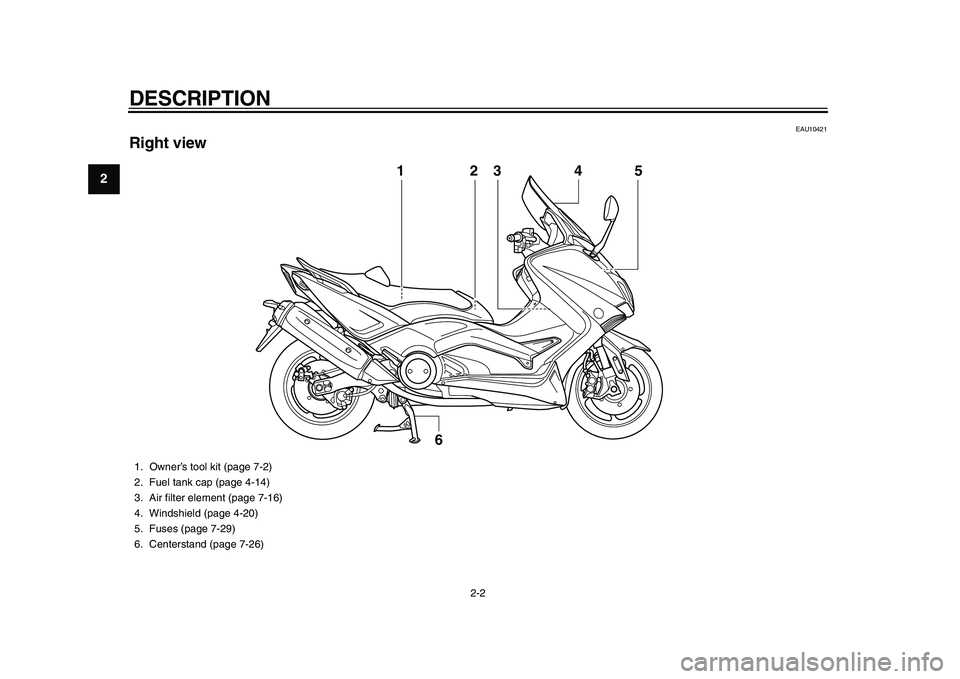
DESCRIPTION
2-2
12
3
4
5
6
7
8
9
10
11
12
EAU10421
Right view
3
6
1
54
2
1. Owner’s tool kit (page 7-2)
2. Fuel tank cap (page 4-14)
3. Air filter element (page 7-16)
4. Windshield (page 4-20)
5. Fuses (page 7-29)
6. Centerstand (page 7-26)
2PW-9-E0_1.book 2 ページ 2015年2月19日 木曜日 午後3時30分
Page 21 of 112

SMART KEY SYSTEM
3-4
1
234
5
6
7
8
9
10
11
12
If the smart key and identification tag of
the mechanical key are both lost or
damaged, and there is no record of the
identification number, the entire smart
key system will need to be replaced.
TIPThe identification number can also be
found on the inside of the smart key it-self.
NOTICE
ECA21573
The smart key has precision elec-
tronic components. Observe the fol-
lowing precautions to prevent
possible malfunction or damage.
Do not place or store the smart
key in a storage compartment.
The smart key may be damaged
from road vibrations or exces-
sive heat.
Do not drop, bend, or subject
the smart key to strong impacts.
Do not submerge the smart key
in water or other liquids.
Do not place heavy items or ex-
cessive stress on the smart key.
Do not leave the smart key in a
place exposed to direct sun-
light, high temperature or high
humidity.
Do not grind or attempt to mod-
ify the smart key.
Keep the smart key away from
strong magnetic fields and mag-
netic objects such as key hold-
ers, TVs, and computers.
Keep the smart key away from
electric medical equipment.
Do not allow oils, polishing
agents, fuel, or any strong
chemicals to come in contact
with the smart key. The smart
key body may become discol-ored or cracked.
TIP
The smart key battery life is ap-
proximately two years, but this
may vary according to operating
conditions.
The smart key battery may be-
come discharged even if it is away
from the vehicle and not being
used.
If the smart key continually re-
1. Mechanical key
2. Smart key
3. Identification number tag12 13
1. Identification number
1
1
2PW-9-E0_1.book 4 ページ 2015年2月19日 木曜日 午後3時30分
Page 22 of 112

SMART KEY SYSTEM
3-5
1
23
4
5
6
7
8
9
10
11
12 ceives radio waves, the smart key
battery will discharge quickly. (For
example, when placed in the vicin-
ity of electrical products such as
televisions, radios, or computers.)
Replace the smart key battery when
the smart key system indicator light
flashes for about 20 seconds when the
power of the vehicle is turned on or
when the smart key indicator light does
not come on when the “ON/OFF”
switch is pushed. (See page 3-6.) After
changing the smart key battery, if the
smart key system still does not operate,
have a Yamaha dealer check the vehi-
cle.
TIPYou can register up to six smart keys
for the same vehicle. See a Yamahadealer regarding spare smart keys.
EAU61673
Smart keyWhen the smart key is turned on and
brought within range, the smart key
system allows you to operate the vehi-
cle without inserting a mechanical key.
To turn the smart key on or off
To turn the smart key on or off, press
and hold the “ON/OFF” switch for ap-
proximately one second. When the
smart key is turned off, the vehicle can-
not be operated even if the smart key is
brought within operating range of the
vehicle. Turn the smart key on and
bring it within range to operate the vehi-
cle. (See page 3-2.)
TIPTo preserve battery power, the smart
key will turn off automatically about a
week after the vehicl e is last used. Turn
the smart key on before using the vehi-cle again.
To use the mechanical key
Press the release button on the smart
key body to extend the mechanical key.
When finished, simply fold the mechan-
ical key back into place.TIPThe mechanical key is used for the fuel
tank cap, the front storage compart-
1. “ON/OFF” switch
2. Smart key indicator light
1
2
1. Mechanical key
2. Release button
12
2PW-9-E0_1.book 5 ページ 2015年2月19日 木曜日 午後3時30分
Page 30 of 112
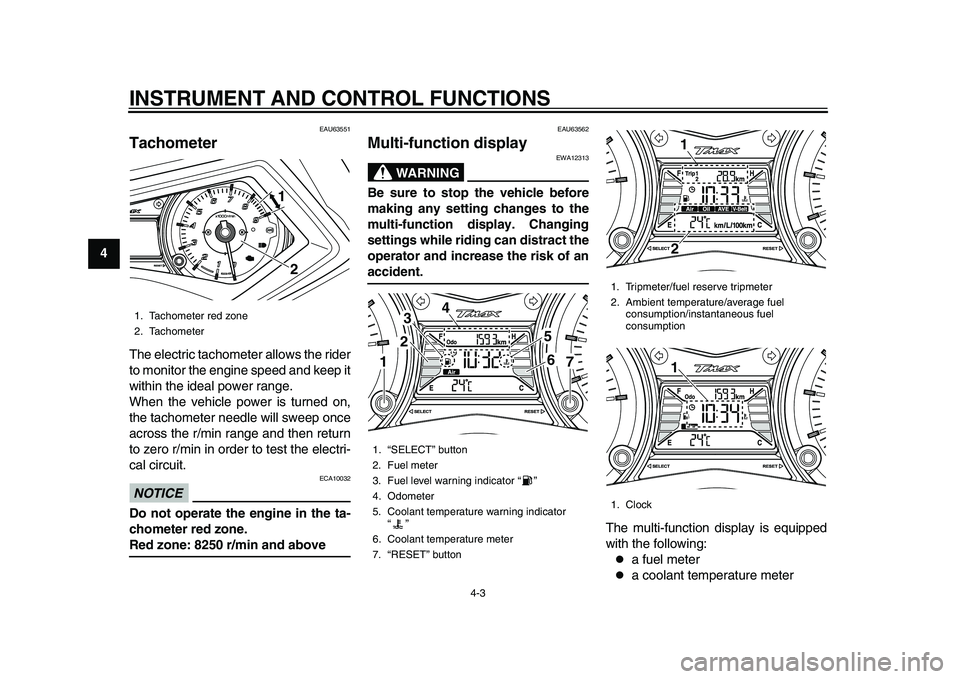
INSTRUMENT AND CONTROL FUNCTIONS
4-3
1
2
34
5
6
7
8
9
10
11
12
EAU63551
TachometerThe electric tachometer allows the rider
to monitor the engine speed and keep it
within the ideal power range.
When the vehicle power is turned on,
the tachometer needle will sweep once
across the r/min range and then return
to zero r/min in order to test the electri-
cal circuit.NOTICE
ECA10032
Do not operate the engine in the ta-
chometer red zone.Red zone: 8250 r/min and above
EAU63562
Multi-function display
WARNING
EWA12313
Be sure to stop the vehicle before
making any setting changes to the
multi-function display. Changing
settings while riding can distract the
operator and increase the risk of anaccident.
The multi-function display is equipped
with the following:
a fuel meter
a coolant temperature meter
1. Tachometer red zone
2. Tachometer
21
1. “SELECT” button
2. Fuel meter
3. Fuel level warning indicator “ ”
4. Odometer
5. Coolant temperature warning indicator “”
6. Coolant temperature meter
7. “RESET” button
23
4
56
11
7
1. Tripmeter/fuel reserve tripmeter
2. Ambient temperature/average fuel consumption/instantaneous fuel
consumption
1. Clock
211
2PW-9-E0_1.book 3 ページ 2015年2月19日 木曜日 午後3時30分
Page 31 of 112
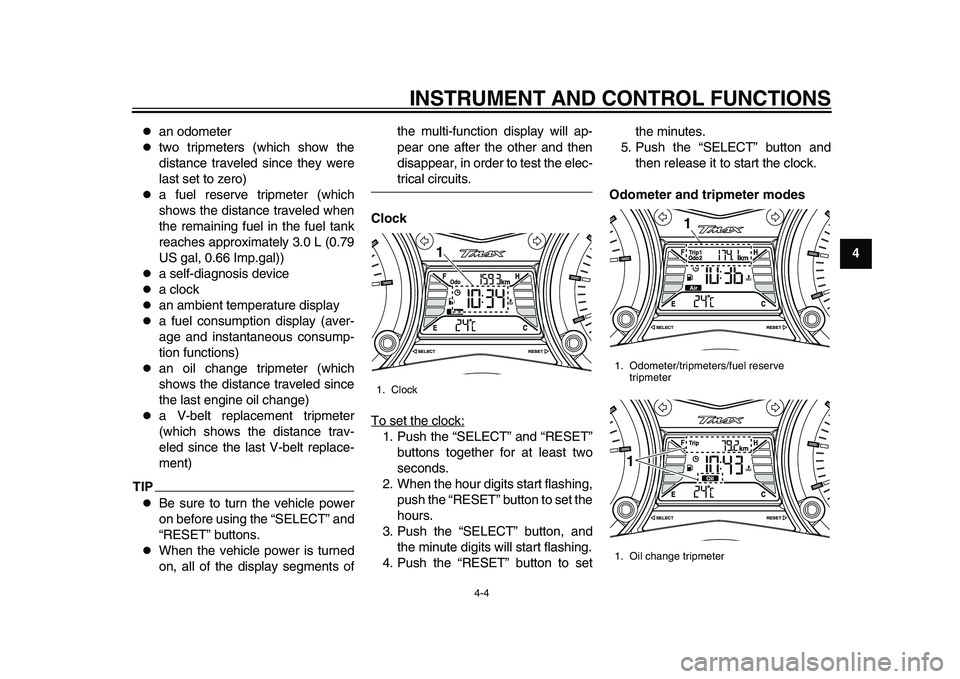
INSTRUMENT AND CONTROL FUNCTIONS
4-4
1
2
345
6
7
8
9
10
11
12
an odometer
two tripmeters (which show the
distance traveled since they were
last set to zero)
a fuel reserve tripmeter (which
shows the distance traveled when
the remaining fuel in the fuel tank
reaches approximately 3.0 L (0.79
US gal, 0.66 Imp.gal))
a self-diagnosis device
a clock
an ambient temperature display
a fuel consumption display (aver-
age and instantaneous consump-
tion functions)
an oil change tripmeter (which
shows the distance traveled since
the last engine oil change)
a V-belt replacement tripmeter
(which shows the distance trav-
eled since the last V-belt replace-
ment)
TIP
Be sure to turn the vehicle power
on before using the “SELECT” and
“RESET” buttons.
When the vehicle power is turned
on, all of the display segments of the multi-function display will ap-
pear one after the other and then
disappear, in order to test the elec-
trical circuits.
Clock
To set the clock:
1. Push the “SELECT” and “RESET” buttons together for at least two
seconds.
2. When the hour digits start flashing, push the “RESET” button to set the
hours.
3. Push the “SELECT” button, and the minute digits will start flashing.
4. Push the “RESET” button to set the minutes.
5. Push the “SELECT” button and then release it to start the clock.
Odometer and tripmeter modes1. Clock
1
1. Odometer/tripmeters/fuel reserve tripmeter
1. Oil change tripmeter
1
1
2PW-9-E0_1.book 4 ページ 2015年2月19日 木曜日 午後3時30分
Page 32 of 112
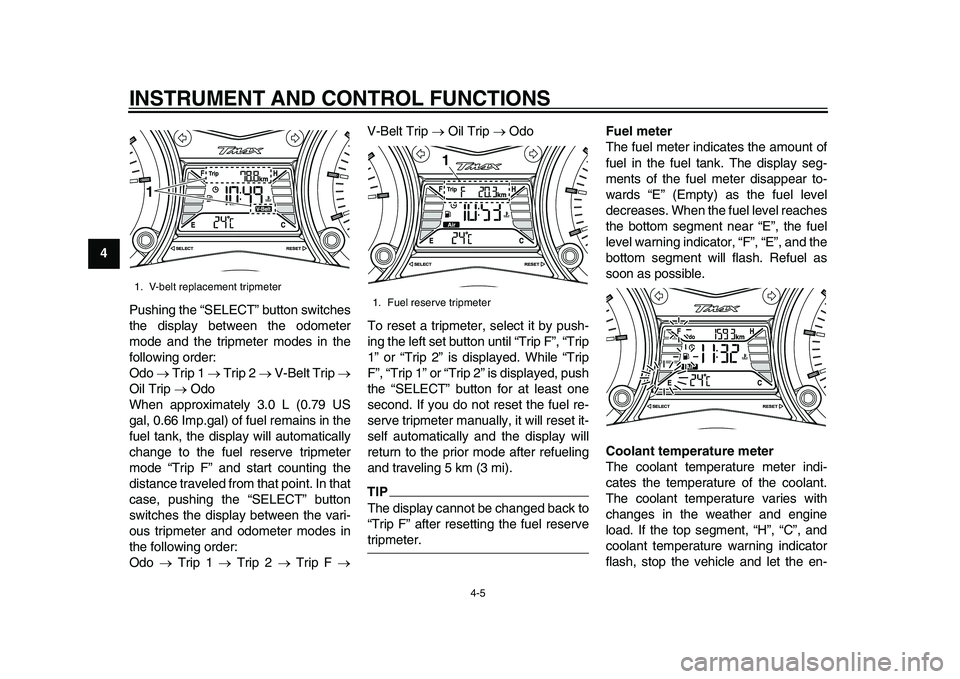
INSTRUMENT AND CONTROL FUNCTIONS
4-5
1
2
34
5
6
7
8
9
10
11
12 Pushing the “SELECT” button switches
the display between the odometer
mode and the tripmeter modes in the
following order:
Odo
Trip 1 Trip 2 V-Belt Trip
Oil Trip Odo
When approximately 3.0 L (0.79 US
gal, 0.66 Imp.gal) of fuel remains in the
fuel tank, the display will automatically
change to the fuel reserve tripmeter
mode “Trip F” and start counting the
distance traveled from that point. In that
case, pushing the “SELECT” button
switches the display between the vari-
ous tripmeter and odometer modes in
the following order:
Odo Trip 1 Trip 2 Trip F V-Belt Trip
Oil Trip Odo
To reset a tripmeter, select it by push-
ing the left set button until “Trip F”, “Trip
1” or “Trip 2” is displayed. While “Trip
F”, “Trip 1” or “Trip 2” is displayed, push
the “SELECT” button for at least one
second. If you do not reset the fuel re-
serve tripmeter manually, it will reset it-
self automatically and the display will
return to the prior mode after refueling
and traveling 5 km (3 mi).
TIPThe display cannot be changed back to
“Trip F” after resetting the fuel reservetripmeter. Fuel meter
The fuel meter indicates the amount of
fuel in the fuel tank. The display seg-
ments of the fuel meter disappear to-
wards “E” (Empty) as the fuel level
decreases. When the fuel level reaches
the bottom segment near “E”, the fuel
level warning indicator, “F”, “E”, and the
bottom segment will flash. Refuel as
soon as possible.
Coolant temperature meter
The coolant temperature meter indi-
cates the temperature of the coolant.
The coolant temperature varies with
changes in the weather and engine
load. If the top segment, “H”, “C”, and
coolant temperature warning indicator
flash, stop the vehicle and let the en-
1. V-belt replacement tripmeter1
1. Fuel reserve tripmeter
1
2PW-9-E0_1.book 5 ページ 2015年2月19日 木曜日 午後3時30分
Page 34 of 112

INSTRUMENT AND CONTROL FUNCTIONS
4-7
1
2
34
5
6
7
8
9
10
11
12 second. When pushing the “SELECT”
button, “V-Belt Trip” starts flashing.
While “V-Belt Trip” is flashing, push the
“SELECT” button for at least three sec-
onds.
If the V-belt is changed before the
V-belt replacement indicator “V-Belt”
flashes (i.e. before the periodic V-belt
change interval has been reached), the
indicator “V-Belt” must be reset after
the V-belt change for the next periodic
V-belt change to be indicated at the
correct time.
The electrical circuit of the indicator can
be checked according to the following
procedure.
1. Turn the vehicle on and make sure that the engine stop switch is set to
“”.
2. Check that the V-belt replacement indicator comes on for a few sec-
onds and then goes off.
3. If the V-belt replacement indicator does not come on, have a Yamaha
dealer check the el ectrical circuit.Ambient temperature display, aver-
age fuel consumption, and instan-
taneous fuel consumption modes
Push the “RESET” button to switch the
display between the ambient tempera-
ture display “Air”, the average fuel con-
sumption mode “AVE_ _._ km/L” or
“AVE_ _._ L/100 km”, and the instanta-
neous fuel consumption mode “km/L”
or “L/100 km” in the following order:
Air
AVE_ _._ km/L or AVE_ _._ L/
100 km km/L or L/100 km Air
For the UK only:
Push the “RESET” button to switch the display between the ambient tempera-
ture display “Air”, the average fuel con-
sumption mode “AVE_ _._ MPG” and
the instantaneous fuel consumption
mode “MPG” in the following order:
Air
AVE_ _._ MPG MPG Air
Ambient temperature display
This display shows the ambient tem-
perature from –9 C to 40 C in 1 C in-
crements.
For the UK only:
15 F to 104 F in 1 F increments.
The temperature displayed may vary
from the ambient temperature. Pushing
1. Ambient temperature/average fuel consumption/instantaneous fuel
consumption
1
1. Ambient temperature display1
2PW-9-E0_1.book 7 ページ 2015年2月19日 木曜日 午後3時30分
Page 35 of 112
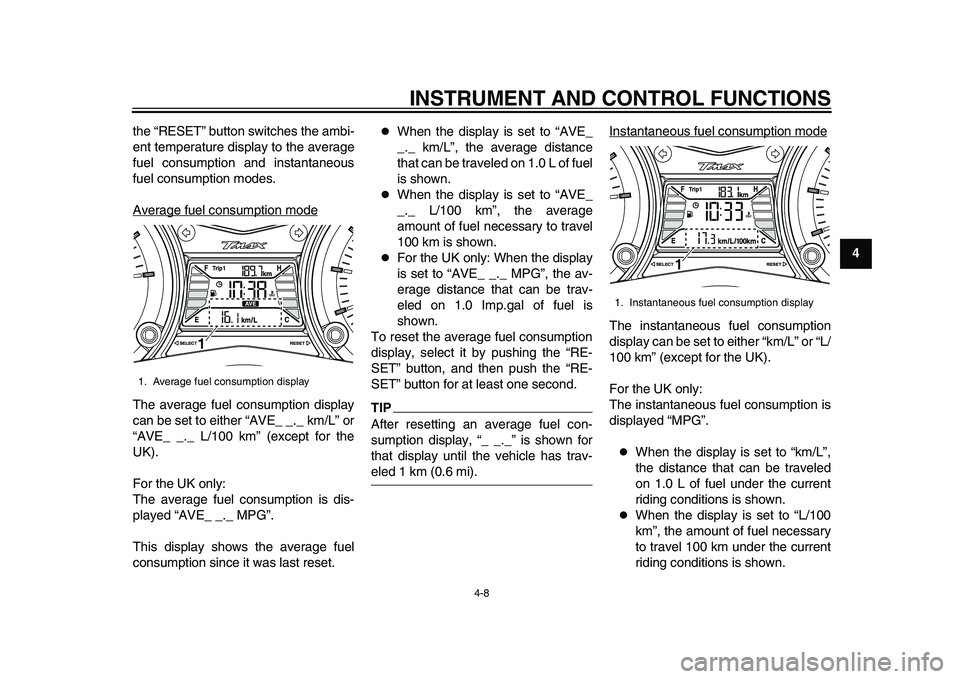
INSTRUMENT AND CONTROL FUNCTIONS
4-8
1
2
345
6
7
8
9
10
11
12
the “RESET” button switches the ambi-
ent temperature display to the average
fuel consumption and instantaneous
fuel consumption modes.
Average fuel consumption mode
The average fuel consumption display
can be set to either “AVE_ _._ km/L” or
“AVE_ _._ L/100 km” (except for the
UK).
For the UK only:
The average fuel consumption is dis-
played “AVE_ _._ MPG”.
This display shows the average fuel
consumption since it was last reset.
When the display is set to “AVE_
_._ km/L”, the average distance
that can be traveled on 1.0 L of fuel
is shown.
When the display is set to “AVE_
_._ L/100 km”, the average
amount of fuel necessary to travel
100 km is shown.
For the UK only: When the display
is set to “AVE_ _._ MPG”, the av-
erage distance that can be trav-
eled on 1.0 Imp.gal of fuel is
shown.
To reset the average fuel consumption
display, select it by pushing the “RE-
SET” button, and then push the “RE-
SET” button for at least one second.
TIPAfter resetting an average fuel con-
sumption display, “_ _._” is shown for
that display until the vehicle has trav-eled 1 km (0.6 mi). Instantaneous fuel consumption mode
The instantaneous fuel consumption
display can be set to either “km/L” or “L/
100 km” (except for the UK).
For the UK only:
The instantaneous fuel consumption is
displayed “MPG”.
When the display is set to “km/L”,
the distance that can be traveled
on 1.0 L of fuel under the current
riding conditions is shown.
When the display is set to “L/100
km”, the amount of fuel necessary
to travel 100 km under the current
riding conditions is shown.
1. Average fuel consumption display
1
1. Instantaneous fuel consumption display
1
2PW-9-E0_1.book 8 ページ 2015年2月19日 木曜日 午後3時30分
Page 36 of 112
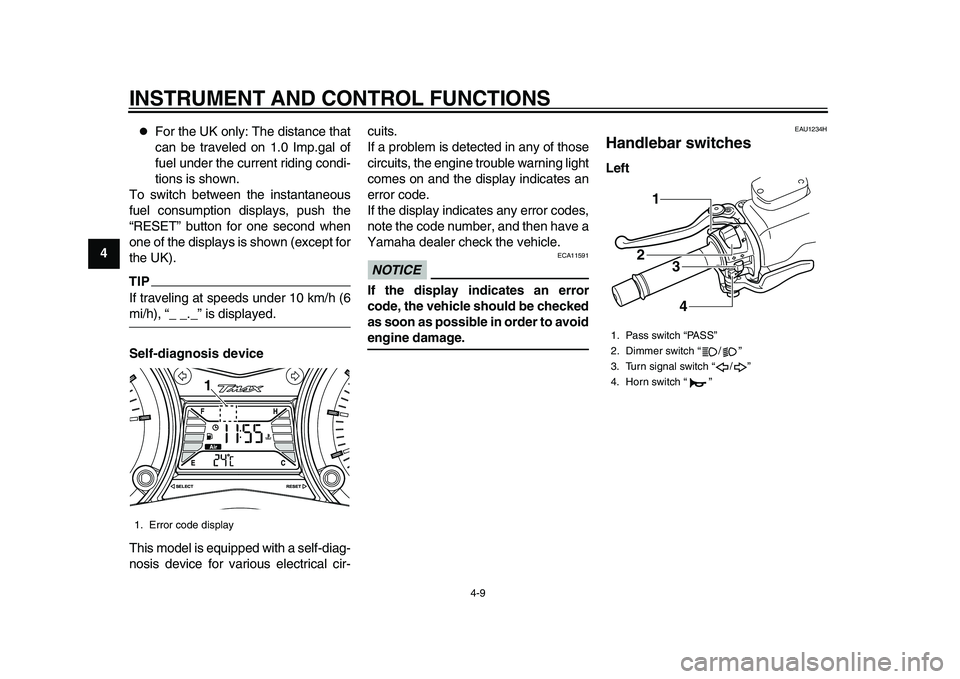
INSTRUMENT AND CONTROL FUNCTIONS
4-9
1
2
34
5
6
7
8
9
10
11
12
For the UK only: The distance that
can be traveled on 1.0 Imp.gal of
fuel under the current riding condi-
tions is shown.
To switch between the instantaneous
fuel consumption displays, push the
“RESET” button for one second when
one of the displays is shown (except for
the UK).
TIPIf traveling at speeds under 10 km/h (6mi/h), “_ _._” is displayed.
Self-diagnosis device
This model is equipped with a self-diag-
nosis device for various electrical cir- cuits.
If a problem is detected in any of those
circuits, the engine
trouble warning light
comes on and the display indicates an
error code.
If the display indicates any error codes,
note the code number, and then have a
Yamaha dealer check the vehicle.
NOTICE
ECA11591
If the display indicates an error
code, the vehicle should be checked
as soon as possible in order to avoidengine damage.
EAU1234H
Handlebar switchesLeft
1. Error code display
1
1. Pass switch “PASS”
2. Dimmer switch “ / ”
3. Turn signal switch “ / ”
4. Horn switch “ ”
1
2
3
4
2PW-9-E0_1.book 9 ページ 2015年2月19日 木曜日 午後3時30分